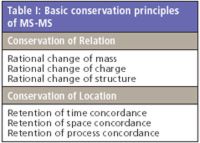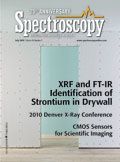Mass Spectrometry–Mass Spectrometry Retrospective
Ken Busch presents a retrospective overview of more than 40 years of mass spectrometry-mass spectrometry (MS-MS) research.

In its early years of development, mass spectrometry–mass spectrometry (MS-MS) was strongly linked to the instruments constructed to complete the measurement. The reverse geometry BE (B is magnetic sector and E is electric sector) sector instrument (1) and the triple-quadrupole mass spectrometer (2) were composed of familiar components, but were reengineered for this new purpose. Reviews of MS-MS (3,4) now offer both overview and retrospective, from the vantage of almost 40 years development. The appearance in 1973 of the classic monograph "Metastable Ions" (5) (now reprinted by the American Society for Mass Spectrometry) helped to focus attention on the reactions undergone by ions moving through a mass spectrometer. Metastable ions had long been recognized as the result of just such reactions, but for a time, instruments were equipped with "metastable ion suppressors" (6) so that these distracting signals would not appear in the recorded mass spectrum. With time, however, understanding of the basic scientific principles evolved, and the ability of these ion reactions to yield analytically useful information became clear. This new thinking was somewhat of a detour from the usual approach in MS, which was to confine ion reactions to the source of the instrument, assume a single charge on the ion (positive or negative), and then to measure the mass of the ion with varying levels of resolution. In MS-MS, ions assume the roles of reactants and products, linked through a chemical reaction, the charge can change during the reaction, and measurements of masses must occur on both sides of the reaction. Many of the complications applicable to studying chemical reactions in the real world, or even in the ionization source of a mass spectrometer, are muted in MS-MS. At least as first practiced, the reactant and the product ions are isolated in the vacuum of the mass spectrometer, and are moving with specified velocities and directions. The parameters of the collision process that induces their reaction could be controlled. The mass spectrometer then becomes a chemical reactor on a mass and volume scale orders of magnitude smaller than the usual laboratory scale.

Kenneth L. Busch
With the commercial availability of instruments for MS-MS in the 1980s, many research groups embarked upon studies of collision-induced dissociation (CID) ion chemistry. These studies continue today, with increased abilities to discern differences in ion structure (7). The first years of analytical development of MS-MS are chronicled in two texts that appeared in the 1980s (8,9). Again, the basic principles are simple in retrospect. Figure 1a is a mass spectrum recorded for a mixture of components all present in the ionization source at the same time. Mass spectra are additive, and so ions from each of the components of the mixture (A, B, C, D, . . . X, Y, Z) appear in the mass spectrum. Signal contributions from multiple components may overlap (and certainly do so for common lower-mass ions), and additionally, the signal at any nominal ion mass can be due to ions of several different structures, or several different compositions. In the process that leads to the result shown in Figure 1b, various ionic contributors are deconvoluted with measurement of mass at a higher resolving power. This process will separate out ions of different formulas, but it will not indicate when ions of the same formula are derived from two different mixture components. Put another way, the more accurate mass information is a characteristic of the ion, but it does not provide any information about the relationship of the ions to each other. The process that leads to the result shown in Figure 1c involves a separate excitation step for MS-MS, and the second-stage mass measurement of ionic products of a dissociation of the mass-selected reactant ion.
One of the earliest well-publicized applications of MS-MS was direct mixture analysis. The emphasis was on the speed of analysis by avoiding the need for extensive sample preparation or chromatographic separations. Figure 2 shows one of the iconic examples of direct mixture analysis in which one component of a complex mixture is "pulled out" of an otherwise featureless mass spectrum (The concept is discussed in reference 10; the figure is adapted from reference 11). The collisional excitation of a mass-selected reactant ion and the mass analysis of the ionic dissociation products (as in the process shown in Figure 1) leads to an increase in the signal-to-noise in the final mass spectrum. At the time these MS-MS capabilities were being touted, higher resolving power mass measurements were still rather uncommon and difficult to perform. Now, 30 years later, Fourier transform (FT)-MS (as an example) provides far more routine high accuracy mass measurements, and has opened up new applications in petroleum analysis. The field was primed for such applications since higher resolving power instruments were used in the 1960s to resolve the sulfur/2 oxygen mass difference in many ions derived from petroleum samples.

Figure 1
In its promise of a speedier analysis, the perceived competitor was gas chromatography coupled with MS (GC–MS). GC itself was in a period of transition from packed columns to capillary columns, with the latter offering higher separating power and often shorter retention times. In retrospect, it is noteworthy that GC–MS itself had only about a 10-year history of application to complex analytical problems. The early MS-MS emphasis on reduced sample preparation and faster analyses was valid, but somewhat out of sync with the needs of the time. The analytical community is inherently conservative. Analysts have always dealt with samples that they separate in time and space, from the time of crystal separation through distillation, and onwards through all of the various forms of column and planar chromatography. Through decades, analysts have grown accustomed to at least some minimal sample preparation (sample collection itself is part of sample preparation), and often that process included sample derivatization as well. That MS-MS could minimize such time-consuming processes was not viewed as an advantage when balanced against the perceived uncertainty in the results obtained. Having embraced the need for a surety of results that resulted from a carefully vetted sequence of actions, the community of the period might have distrusted a method that seemed to provide "something for nothing." The need for sample throughput continued to grow, however, and MS-MS continued to be developed for rapid analyses of targeted components in mixtures, using the full range of product ion, parent ion, and neutral loss scans.

Figure 2
In retrospect, we recognize the next major shift in the development of MS-MS, and it had nothing to do with the mass analysis and everything to do with ionization. The development of electrospray ionization (ESI) and matrix-assisted laser desorption ionization (MALDI) resulted in the forcible separation of the two major uses of MS: molecular mass determination and structural determination through spectral interpretation. In the beginning at least, ESI and MALDI ionization methods produced intact ions of molecular species, whether they be singly or multiply protonated in the case of positive ions. The distribution of multiply charged molecular ions typical of positive-ion ESI mass spectra of higher molecular mass peptides, for example, is emblematic of this shift. All of those different-mass and different-charge species could be combined together mathematically to provide a precise molecular mass determination. But the information ended there. After the determination of molecular mass, the pattern of fragment ions provides clues of structure in electron ionization and chemical ionization. But for ESI, there were no dissociations, and no spectral pattern to interpret. Dissociation of these higher mass ions would force them into their smaller product ions, the masses of which would divulge the sequence. How to do so? CID had already been developed for MS-MS of ions derived from other ionization sources, and so there was a transfer of application of the (by now) standard MS-MS experiment. Although there are now newer means of excitation of the mass-selected ions, notably electron transfer dissociation (ETD) and electron-capture dissociation (ECD), the natural marriage of ESI or MALDI with MS-MS was (again in retrospect) inevitable.
Professor Cooks, one of the pioneers of MS-MS, wrote about creativity in MS in an A-page article (in which only a single figure was a mass spectrum) (11). The process of development of instrumentation that he describes is a retrospective of sorts, but also a challenge guide for the future. Indeed, many years after the core tenets of MS-MS were put into place, new experiments to create new information continue to be described in the research literature (12–14). It should be apparent now that MS-MS is a collection of procedures in which ions can be forced to react, and in so doing, provide useful information about their mass and structure. As we consider all of the means in which we do so, two basic conservation principles become apparent (Table I). These are described as conservation principles, because the value of the information obtained is intrinsically derived from preservation of the the linkage described. The first principle is Conservation of Relation, with three subcategories related to the three central changes in ion character that can be accessed though MS-MS (9). Given a collection of ions that may change their mass, their charge, or their structure and subsequent reactivity, there must be a rational connection between the reactant and the product ions. For instance, a loss of 28 Da that is established to be a loss of CO through a mass measurement must be linked to an ionic structure that rationally could lose CO. The requirements of that linkage, either through mass, charge, or structure, allows impossible or improbable reactions to be removed from consideration. Removal of the impossible, through a sequence of steps, highlights the probable with increasing precision. The principle extends across all of MS-MS, even to experiments not yet demonstrated. For example, we have only "scratched" the surface of using surfaces to facilitate displacement reactions based upon very specific shapes, sizes, charges, and masses. Gas-phase derivatization reactions can be adapted to work on surfaces and the amount of reagents is infinitesimal. Isotopic information is still greatly underutilized in MS-MS. Isotopic substitution can be introduced as part of the gas phase processing of an ion.
The second principle (Table I) is Conservation of Location, again with three subcategories of time and space and process. As an example of time concordance, consider the selected-reaction monitoring experiment used to analyze for a targeted component in a mixture. This MS-MS experiment usually includes column chromatography to introduce sample components to the ionization source of the instrument. For simplicity, we describe a product ion MS-MS scan in which product ions (one or a few) from the collision-induced dissociation of a mass-selected reactant ion are recorded. Plotted on a time axis, the measured signal should maximize uniquely in time at the expected retention time of a targeted component. All of the expected product ions should maximize at the same retention time (and in rough parallel to their expected abundances). Reactant-ion-to-product-ion transition signals that occur at other than the mandated retention time are due to components other than the targeted component. The principle of Conservation of Location includes the retention time. Similarly, the concordance in space includes the analogous principle in planar chromatographies, or in sampling itself. Finally, MS-MS is a process, but it is not chaotic. Ion A that dissociates to ion B that dissociates to ion C provides information not only through the first principle of conservation, but also from the second. Ion C that forms directly from ion A without the involvement of ion B may represent a distinct situation. An example of this principle in action is the reaction intermediate scan in MS-MS (13).

Table I: Basic conservation principles of MS-MS
Even when potential long-term value of a new analytical method seems confidently foreseen, as with MS-MS, the developmental paths actually followed can never be forecast with confidence. In the LC-MS retrospective described in the first paragraph of this article, Jack Henion emphasized the need to match a method with a problem, and to develop results as well as promises. But even real applications demonstrated early on in the development of an analytical method can be swept aside by unexpected developments in other areas. In the case of MS-MS, it was the development of new ionization methods that opened up broader areas of applications for MS, coupled with the information needs for proteomics, and the automated interpretation of massive amounts of data. With humility, we must admit that the predominant applications of MS-MS today are in areas quite different from what was foreseen. Prognostication is always chaotic, but there is more reconstruction to come. MS-MS will soon be recast as a process of knowledge management, when that knowledge derives from mass and charge measurements on ions, but also from their reaction chemistry, and the ability to probe that chemistry. We naturally grow more confident with issues of nanochemistry and the manipulation and creation of nanomaterials. Yet a simple calculation shows that mass spectrometry's routine ability to deal with picograms of sample for a peptide with a molecular mass of 10,000 constitutes materials processing on the femtochemistry scale. The imagination of other scientists is outpaced by actual accomplishments. Our full embrace of the femtoenvironment includes accepting the challenge to fashion minute amounts of reagents, or the miniscule surfaces to process and transform ions, and to apply the conservation principles of MS-MS to derive useful information from the results of those experiments.
Kenneth L. Busch believes that the ions know what they are doing. Current popular science described as nanochemistry is just a few scalar decades removed from the femtoenvironments in which mass spectrometry has operated for years. With better instruments, and more creative experiments, we will continue to operate more surgically in those femtoenvironments. The author is solely responsible for the contents of this column; all 9 × 1019 fg of him can be reached at wyvernassoc@yahoo.com.
References
(1) J.H. Beynon, RG. Cooks, J.W. Amy, W.E. Baitinger, and T.Y. Ridley, Anal. Chem. 45, 1023A (1975).
(2) R.A. Yost and C.G. Enke, Anal. Chem. 51, 1251A (1979).
(3) E. de Hoffmann, J. Mass Spectrom. 31, 129–137 (1996).
(4) J.H. Futrell, Int. J. Mass Spectrom. 200, 495–508 (2000).
(5) R.G. Cooks, J.H. Beynon, R.M. Caprioli, and G.R. Lester, Metastable Ions (Elsevier, New York, 1973).
(6) F.L. Mohler, V.H. Dibeler, and R.M. Reese, J. Chem. Phys. 22, 394 (1954).
(7) A.G. Harrison, J. Amer. Soc. Mass Spectrom. 20, 2248–2253 (2009).
(8) F. W. McLafferty, Tandem Mass Spectrometry (Wiley, Hoboken, New Jersey, 1983).
(9) K.L. Busch, G.L. Glish, and S.A. McLuckey, Mass Spectrometry/Mass Spectrometry: Techniques and Applications of Tandem Mass Spectrometry (VCH, New York, 1988).
(10) K.L. Busch, Spectroscopy 18 (5), 52–55 (2003).
(11) R.G. Cooks, Anal. Chem. 57, 823A (1985).
(12) J.R. O'Lear, L.G. Wright, J.N. Louris, and R.G. Cooks, Org. Mass Spectrom. 22, 348–358 (2005).
(13) M. Vincenti, J.C. Shwartz, R.G. Cooks, A.P. Wade, and C.G. Enke, Org. Mass Spectrom. 23, 579–589 (2005).
(14) S.C . Habicht, N.R. Vinueza, P. Duan, M. Fu, and H.L. Kenttämaa, J. Amer. Soc. Mass Spectrom. 21, 559–562 (2010).

LIBS Illuminates the Hidden Health Risks of Indoor Welding and Soldering
April 23rd 2025A new dual-spectroscopy approach reveals real-time pollution threats in indoor workspaces. Chinese researchers have pioneered the use of laser-induced breakdown spectroscopy (LIBS) and aerosol mass spectrometry to uncover and monitor harmful heavy metal and dust emissions from soldering and welding in real-time. These complementary tools offer a fast, accurate means to evaluate air quality threats in industrial and indoor environments—where people spend most of their time.
NIR Spectroscopy Explored as Sustainable Approach to Detecting Bovine Mastitis
April 23rd 2025A new study published in Applied Food Research demonstrates that near-infrared spectroscopy (NIRS) can effectively detect subclinical bovine mastitis in milk, offering a fast, non-invasive method to guide targeted antibiotic treatment and support sustainable dairy practices.